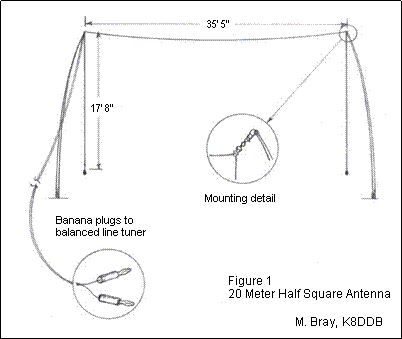A 20 Meter Half Square Antenna for QRP Portable Operation
by Mike Bray, K8DDB
I’ve always enjoyed tinkering with wire antennas with the hope of finding a magic configuration that was easy to erect and also made good use of the meager power from my QRP rig. The idea for a portable half square came about while learning to use EZNEC1 antenna modeling software.
I found that I could get a fairly good radiation pattern with the horizontal portion of a 20-meter half square antenna only 20 feet above the ground. I decided to use two SD-202, 20 foot telescoping fishing poles to support the antenna. They are light weight and collapse to a length of 4 1/2 feet. The base of the poles are fitted with a 1 1/4 inch PVC sleeve, PVC fittings, a wooden dowel and a 12 inch spike for easy mounting in average soil.
 The half square is made of a two strand computer ribbon cable 100 feet long, 47 feet of which is used for the balanced feed line. The remainder of the cable is peeled apart to form the radiating elements. The vertical elements are 17’ 8” long and the horizontal element is 35’ 5” (see Figure 1.) Using ribbon cable for the feed line is not the most efficient approach, but I felt it was an acceptable compromise for the sake of portability.
The half square is made of a two strand computer ribbon cable 100 feet long, 47 feet of which is used for the balanced feed line. The remainder of the cable is peeled apart to form the radiating elements. The vertical elements are 17’ 8” long and the horizontal element is 35’ 5” (see Figure 1.) Using ribbon cable for the feed line is not the most efficient approach, but I felt it was an acceptable compromise for the sake of portability.
The antenna is attached to the SD-20 poles with fishing swivel-snaps, one at each corner. The swivel-snaps are held in place with nylon tie-wraps. Small fishing sinkers are attached the vertical element ends after the antenna is erected to keep them taut. Banana plugs are placed on the end of the feed line to allow easy attachment to my Emtech ZM-23 tuner which is used as an interface between the rig and antenna. The antenna is stored on a 7 inch tape reel, which allows for tangle-free deployment and compact storage.
The SD-20 poles are made of graphite and tend to detune a resonant antenna if the wire is close to the poles. To solve that problem, I spread the base of the poles a few more feet apart than the horizontal part of the antenna. The poles flex to keep the horizontal part taut and the vertical elements away from the poles. The antenna is easy to erect, and by using two SD-20 poles it can be set up independent of other supporting structures. In addition, the antenna can be "rotated" by moving the pole that is the farthest from the feed point in an arc.
Does it work? Within a month of building the half square I had worked 21 states, Italy, Belarus and three Australian stations QRP, one of which was Alan, VK6PG, in Noranda Western Australia. The distance to his QTH is 10,869 miles, my farthest QRP QSO yet!4
As a further test, I decided to try the 20 meter half square and my Sierra for Field Day 2002. My cousin Don and I operated class 2B-Battery from Lake Mary Park, about a half mile from my home. Our intention was to operate casually, only a few hours each day. So, we had to break down our stations Saturday afternoon and set up again Sunday morning. Setup and breakdown were easy, taking only about 20 minutes including the antenna and rig. I had 91 QRP QSOs using the half square: 39 on 20 meters, 41 on 15 meters, 9 on 40 meters and 2 on 10 meters. The antenna seemed to perform well on 20 and 15 meters.
I’d say the half square is a good compromise between performance and portability. If you enjoy portable operation as I do, give my half square antenna a try, I think you’ll like it!
Notes:
1 A free demo version of EZNEC antenna modeling software can be downloaded at:
http://www.eznec.com/demoinfo.htm
2 One source for the SD-20, telescoping 20 foot fishing pole is WorldRadio Magazine. The current price is $19.95: http://www.wr6wr.com/
3 The Emtech ZM-2 QRP tuner will handle a maximum power of 15 watts. The kit is currently priced at $65 and the built version is $90.
http://emtech.steadynet.com/zm2.shtml
4 See companion article "The Thrill of QRP"
 The half square is made of a two strand computer ribbon cable 100 feet long, 47 feet of which is used for the balanced feed line. The remainder of the cable is peeled apart to form the radiating elements. The vertical elements are 17’ 8” long and the horizontal element is 35’ 5” (see Figure 1.) Using ribbon cable for the feed line is not the most efficient approach, but I felt it was an acceptable compromise for the sake of portability.
The half square is made of a two strand computer ribbon cable 100 feet long, 47 feet of which is used for the balanced feed line. The remainder of the cable is peeled apart to form the radiating elements. The vertical elements are 17’ 8” long and the horizontal element is 35’ 5” (see Figure 1.) Using ribbon cable for the feed line is not the most efficient approach, but I felt it was an acceptable compromise for the sake of portability.